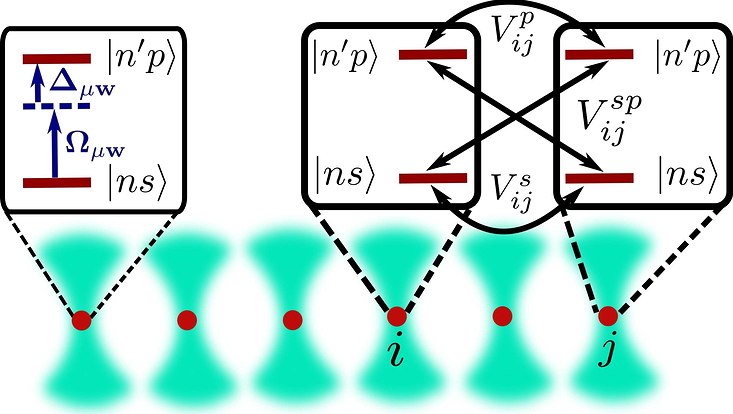Imaging of Matter
Competing Interactions of Rydberg Atoms
23 November 2023

Photo: UHH, AG Schmelcher
The competition between the long- and short-range interactions of Rydberg atoms has strong impact on their quantum phases. In "Physical Review Letters", a research team led by Prof. Peter Schmelcher and comprising the CUI PhD student Zeki Zeybek as well as Dr. Rick Mukherjee from the Department of Physics describes a new research avenue to design such novel phases and discusses possibilities of experimental implementation.
The interplay of short- and long-range interactions are responsible for diverse phenomena having significance across various domains in science. For instance, short-range Van der Waals interactions help to stabilize the interior structure of proteins whereas dipole-dipole interactions influence the overall folding procedure as well as interactions with other molecules. Exotic quantum phases with competing orders arise from coexistence of short- and long-range interactions in many-body systems.
However, the study of these phenomena in their natural setting is challenging due to the limited control and the finite temperature environments. This has led to a rapid growth in the use of ultracold systems for quantum simulation of many-body problems. The unprecedented control achieved in these platforms over the system parameters has facilitated probing physical scenarios that are difficult if not impossible to achieve in conventional solid-state systems.
New approach combines short- and long-range interactions
In the current work, the researchers consider an alternative approach to study many-body physics emerging from the combined effects of short- and long-range interactions. By using Rydberg atoms with both Van der Waals and dipole-dipole interactions, they studied the ground state phase diagram in one-dimensional lattices with uniform and dimerized configurations.
In the uniform configuration, the scientists reveal the flexibility in accessing different regimes of the ordered and liquid phases. The competition between the interactions leads to having competing boundaries between the gapless Luttinger liquid and the gapped density-wave phases.
In the dimerized configuration, apart from realizing the individual phases of bond-order and density-wave, they obtain bond-order-density-wave phases that exhibit bond and density-wave orders simultaneously. Finally, the researchers discuss the experimental feasibility of realizing such phases.
Publication
Zeki Zeybek, Rick Mukherjee, and Peter Schmelcher
“Quantum Phases from Competing Van der Waals and Dipole-Dipole Interactions of Rydberg Atoms”
Phys.Rev.Lett. 131, 203003 (2023)


